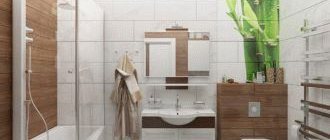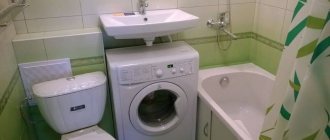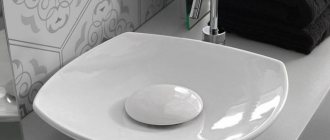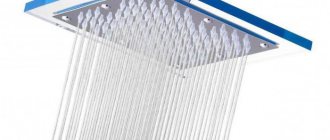Installing a washing machine in the kitchen will be the optimal solution for small apartments and houses. Developers often save space on the bathroom, but one can only dream of a separate room where there would be a dryer, washing device, ironing board, cabinets and shelves for household chemicals. Therefore, many people use the kitchen as an alternative option.
Different experts express opposing opinions about this arrangement of the mechanism. Some give many arguments in support of this decision, others refute them. The choice of the best place in your own home always remains with its owner. To cope with the task, he can listen to different points of view, take advantage of the experience of professionals, and consider ready-made examples.
Models of washing machine for the kitchen
Choosing the appropriate option is a simple task that is easy to cope with, but there are some nuances here. For a large room, any equipment is suitable; for small rooms, the number of possible types of objects is small. First of all, it is necessary to decide on a number of basic parameters inherent in different products, namely:
- type of laundry load;
- overall characteristics;
- installation method.
You should also take into account a number of criteria that play an important role: noise level, energy saving class, spin class, type of control, the presence of child protection, leak protection, and other additional features. If you decide in advance on all the features, then the number of specific models that will meet the requirements is reduced to a minimum.
By way of loading laundry
According to this parameter, all devices are divided into two types: frontal, vertical. In the first case, the laundry is loaded through a hatch located on the front side of the product, in the second, things enter the tank from above. Both options perform the same function, but there are no fundamental differences in the quality of washing. Let's take a closer look at each type:
- Frontal. The most popular model. It is characterized by a relatively low cost and the ability to monitor the washing process through a transparent window located on the door. It can be built into furniture and will fit perfectly into any kitchen interior. However, you will have to bend down when loading things, and you will need free space to open the door.
- Vertical. It is possible to add an item while washing; you don’t have to bend over to load laundry; the lid comes off upward, so there is no need for free space on the side. But this option costs a quarter more than the horizontal one, and it cannot be built into furniture.
If we compare both types, then in most cases preference is given to the first. This is due to the more advantageous appearance of the front products, the ability to use the top panel as an additional shelf, and they can also be built into furniture or placed under the sink.
Dimensions and size
When choosing the dimensions of a washing machine, take into account the space allocated for it, as well as the installation method, whether it will be a free-standing model or it must be built into the kitchen unit, closed with a door. There are various products that can be easily installed in any place, even the most inaccessible one. Using the table as an example, we will consider the existing types of equipment depending on size:
| Dimensions | Frontal | Vertical | |||
| Full size | Narrow | Ultra-narrow | Compact | ||
| Height, cm | 85-90 | 85-90 | 85-90 | 68-70 | 85-90 |
| Width, cm | 60 | 60 | 60 | 47-50 | 40 |
| Depth, cm | 60 | 35-40 | 32-35 | 43-45 | 60 |
| Loading, kg | 4-7 | 3,5-5,2 | 3,5-4 | 3 | 4-7 |
Built-in or freestanding
Manufacturers, taking into account the needs of the consumer, produce different models of equipment, which, according to the installation method, are divided into two types: free-standing, built-in. Each type has its own advantages and disadvantages. To choose the right product, let’s look at each option in more detail:
- Freestanding unit. The most common type of washing machine. From the name itself you can understand that the item will be located separately from the furniture set, stand away from the refrigerator, gas, electric stove, kitchen table. Some specialists manage to build in such models, which ultimately leads to a reduction in their service life.
- Embedded devices. In turn, they are divided into two types: fully built-in, with the possibility of embedding. The first type is completely covered with kitchen furniture panels. The second one can be installed under the tabletop, placed freely. Unlike standard ones, built-in products are protected on the sides by durable metal sheets. The main feature, except that they are not visible, is the absence of noise and vibration during the washing process, which is achieved by rigidly fixing the unit.
Dimensions of built-in washing machines
There are several ways to install SM under the countertop of a kitchen unit. The choice of a specific installation option will also depend on the dimensions of the equipment itself.
Built-in with special fasteners for facades
The cabinet doors are hung on metal hinges on the front of the machine. This allows the SM to fit perfectly into the interior and make its use more comfortable.
This option is already pre-set in dimensions that are ideal for integration into a standard kitchen cabinet.
- Width for installation – 60 cm;
- Installation depth: 55 – 60 cm.
- The standard height varies between 82-83 cm. The height-adjustable legs of the kitchen set allow you to ideally adjust the equipment to the dimensions of the furniture.
With equipment made specifically for embedding, as a rule, there are the fewest problems in terms of installation and selection of dimensions. But there is one significant drawback - high cost.
Embedding a stationary washing machine with a door under the countertop
Stationary washing machines have their own height standard - 85 cm. But this option can also be installed under the countertop in an open position and hidden behind the door. Many manufacturers, adapting to customer requests, make the top cover removable. This allows you to reduce the height of the equipment by the very necessary 2-3 cm.
Full-size SM have a standard depth of 55-60 cm and a width of 58-60 cm. It is worth keeping in mind that this option, with a standard kitchen cabinet depth of 60 cm, will extend somewhat beyond the facade. This means that you won’t be able to hide a full-size washing machine behind the door. But narrow models with a depth of up to 45 cm and even up to 35 cm can fit perfectly with all the hoses and taking into account the protruding hatch.
For an analysis of important points, watch the video:
Installation of open CM (without door)
As already stated above, the dimensions of full-size cars, mainly the depth, do not allow them to fit behind the facades. But what if a large family still needs a spacious washing machine? It is for this case that this embedding method is suitable.
This option is also the simplest. But several important points still need to be taken into account at the kitchen planning stage:
- prepare a niche the width of CM in advance;
- Correctly calculate the height of the countertop set above the floor so that the washing machine fits perfectly in height.
Despite the fact that the interior with an open washing machine does not look so complete, this arrangement also has its advantages:
- no problem with choice. The stationary SM market is the largest. There will be no difficulties with the selection of dimensions, brand, or design;
- the cost of such machines starts from 9 thousand rubles.
Installation from the end of the headset or in the island
A non-standard way of arranging the CM, which first of all will require a complete match between the depth of the lower cabinets and the width of the machine. As a rule, this standard value in both cases is 60 cm.
In this way, you can arrange even very narrow SM models with a depth of up to 35-40 cm, if you select a kitchen module that matches the dimensions of the built-in.
Top loading washing machine
How do they benefit?
Firstly, they are very compact. The width of most models does not exceed 40-45 cm with a depth of 60 cm.
Secondly, their cost starts from only 4 thousand rubles, and the choice on the market is growing every year.
But their downside is that the module for the SM will most likely need to be made to order, just like the folding tabletop.
Options and installation location
You can install the equipment in almost any area: under the work area, window sill, bar counter, in a cabinet, closet, niche, corner. Depending on the chosen model, it is placed in the following ways:
- separate from kitchen furniture;
- partially built under the countertop;
- completely hidden in the headset.
When choosing the optimal location, experts recommend adhering to certain rules:
- It is advisable to install the product near utilities, next to the riser and water supply, where the sink is usually located.
- If the kitchen has a dishwasher, it is better to place them on opposite sides of the sink.
- The refrigerator, oven, and dishwashing unit should be located as far away as possible, since the vibration created has a negative impact on the operation of compressors and built-in fans.
- When using front-facing models, allow for free space to open the door.
- Access to hoses and pipes that supply and discharge water must be free.
Full embedding
Built-in washing machines allow you to rationally use the kitchen space; they are not visible, so they do not affect the design of the room. This type of technology is characterized by convenience and practicality. This is the best option for small rooms. However, when choosing a product, you will have to focus on the parameters of the kitchen furniture, so the width and depth indicators are critical. You should also maintain a distance from the cabinet door to the device; it should be 5-10 cm. When choosing this option, you need to decide on the installation location:
- Under the sink. This is very convenient, because in most cases the cabinet under the sink is not occupied by anything, while the plumbing connections are nearby. The downside is that when replacing hoses, clogged sewers, or in other unpleasant situations, you will have to pull out the equipment every time.
- In a separate closet. The unit can not be installed on the floor, but occupy the middle compartment, under which another bedside table can be located. Some experts manage to hide standard models in a cabinet.
- Under the bar counter. If in previous cases it was possible to install only front-type machines, then this method is suitable for vertical models. The main thing is to provide for the presence of a folding tabletop. The only drawback of this placement is the distance from the riser and pipes with cold water.
Partial embedding
For partial installation, technology that matches the existing interior is suitable. For example, a refrigerator, automatic machine, gas oven, furniture facade have the same color. If the device does not match the design of the room, then it is hidden behind a decorative door. You can also install a stationary product, taking into account its dimensions. There are two ways to locate the unit under the countertop: with an open facade or a hidden door. Let's consider each of the options in detail.
Installation in a niche
The location of the device under the countertop is convenient. It can occupy a corner place near the wall next to the sink. The equipment will be hidden on three sides, but the front will remain open. But do not forget that it must be removed from other equipment. If this is not possible, there is an oven nearby, good thermal insulation between objects should be provided.
This installation method is very simple. All you need to do is select a product that is appropriate in size and connect it to the communications. However, the machine may not fit into the interior of the room or match its color; in this case, a special film is used to cover the facade.
Installation in a niche under a table top with a door
Various items can be located under the countertop: dishwasher, freezer, oven. These elements do not always correspond to the chosen direction of room design, especially when the floor, walls, and furniture façade are designed in the same style. Therefore, devices are often hidden behind the door. The washing machine is no exception.
When choosing a suitable model, measure its depth not by the body, but by its door and the most protruding parts. This arrangement is convenient because, if necessary, to protect the product from children, it can be locked. If there is other built-in equipment, vibration is taken into account; to reduce it, a gap is made between the side walls and the device on each side of at least 2 cm.
Stationary accommodation
For stationary placement, a regular freestanding machine is suitable. This is the easiest installation method. If desired, it can be placed in any free area in the kitchen, removed from the work area, or hidden behind a screen or curtain. It is enough to find a suitable place and connect the device to the plumbing communications.
The equipment is not covered by anything on the sides or front, so with this arrangement you can use frontal and vertical options. These models are usually purchased either to save money, or when the kitchen is renovated, there is simply nowhere to install the unit.
The fixed method is the most budget-friendly, in which there is no need to equip a special place in the closet or engage in its manufacture. However, when determining the optimal point, it is worth considering general recommendations, not to remove the object from the riser and pipes with cold water. The best option remains the area around the kitchen sink.
Installation
Is it possible to place a washing machine in the kitchen or hallway? The answer is yes.
To do this, you only need to know a few mandatory rules and requirements:
- The foundation under the washing machine must be solid (in the case of multi-storey apartments - reinforced concrete). Installing a washing machine in the kitchen will be a simple matter if you make smooth floors in advance.
- In general, almost every model of washing machine is equipped with short thin legs, with which you can adjust the equipment according to its level.
Choosing a suitable place
Ideal location
The location of the washing machine in the kitchen depends not only on the design and interior of the kitchen space. Try to place the unit as close to the outlet as possible in order to connect it directly, without the use of additional devices.
If this is not possible and the standard length of the cord is not enough for you, then you can use the services of a service center - a specialist will come to your home and replace the standard cord with a longer one for an additional fee.
Advice! For washing machines, it is better to make separate sockets connected directly to the distribution panel.
After the floors are poured, the machine is installed in the chosen place and the legs are adjusted, it is necessary to carry out a control check - holding the cover of the unit, try to swing it. When everything is done correctly, you are unlikely to be able to rock the machine.
Now swing the unit diagonally - the vibration amplitude should be the same. Well, you’ve succeeded, now the question is: how to install a washing machine in the kitchen? The stage has been passed for you!
Electrical connection
Separate socket for the machine
Connecting a washing machine in the kitchen is the most difficult and important part of the entire work process. When turned on, it can consume from 200 to 400 W of electricity.
Attention! When connecting this household unit, you should pay attention to the fact that it itself heats the water to the required temperature.
Due to the fact that the washing machine runs on electricity, there is a risk of electric shock to a person in the places where they are installed - the manufacturer of the automatic machine equips it with a special grounding, when semi-automatic machines are protected by double insulation (on the automatic machine, the grounding is located in the Euro plug, in the form of a special plate) .
Therefore, to connect an automatic washing machine, it is customary to use special sockets, popularly known under the symbol “euro”. A regular outlet is designed for a voltage of no more than 6A, while the “euro” analogue has an operating voltage of 16A.
Often, when connecting household appliances to the network, we use all kinds of tees and extension cords. But, it should be noted, they significantly reduce the degree of protection of both the washing machine and the outlet. The devices become a fire hazard and can cause a short circuit in the network.
Important! When buying a new outlet, pay attention to its “internals”. High-quality products have a ceramic “filling”.
Connection to cold water supply
Cold water connection
The European standard for connecting a washing machine to a cold water supply is when a separate screw is located directly above the unit. This screw is designed to shut off the water to the automatic machine when it is not in use.
It is also necessary to turn off the tap - one fine day, when the tap is open, the pressure can simply knock out the tank, and water will spread not only throughout your kitchen, but will also pour on your neighbors’ heads.
So, let’s greatly simplify the task and place the tap in the most convenient place for you, namely, on a free section of the pipe. For installation you will need a valve (it is better to choose a Spanish-made ball type). The larger the diameter of the ball, the better it will be.
Special tap
Note! In order to install the valve, you will need to call a welder who will install the valve on the pipe.
If you are quite familiar with plumbing and are not picky about European standards, you can make everything much simpler:
- To begin, unscrew the hose connecting the mixer and the pipe;
- We screw the tee onto the vacant space (don’t forget about fum tape or tow);
- We screw the water supply hose to the mixer into the upper outlet of the tee, and install a special tap into the side outlet that limits the water supply to the washing machine;
- We connect the water intake hose from the washing machine to the tap - that’s it, the work is finished.
This type of connection is not only the simplest, but also the most profitable. The price for a faucet is about 100 rubles, a fum tape is 20 rubles, a tee is from 30 to 50 rubles. That is, connecting a washing machine in the kitchen will cost you no more than 200 rubles (if you call a plumber, you will have to pay about 700-1000 rubles for his work).
Is a hot water connection necessary?
If you connect the washing machine to both hot and cold water, then both hot and cold water will be poured into the unit’s tank at the same time. The temperature at which the clothes will be washed will be 40˚, which is fully consistent with all modern standards.
The automatic washing machine does not require refilling with hot water and can only be connected to cold water. Special heating elements located inside the unit will heat the water to a temperature depending on the mode you choose.
Attention! Connecting to a hot water supply can cause a lot of problems when washing delicate items - for example, you can simply weld your sweater in the machine or redye a snow-white blouse.
Features of placing a washing machine in a 6 sq.m. kitchen. m
Every housewife dreams of a large, bright kitchen. Many residents living in Khrushchev-era buildings have to be content with a small room, the area of which is 6 m². But even with its small dimensions, I want to make this little thing functional and place most household appliances in it.
It is difficult to fulfill your plan; after arranging everything you want on a small square, there should be enough free space where all family members could gather at the table. The best option in the kitchen would be to use built-in appliances; they can be installed:
- in the nightstand under the sink, behind the door of the kitchen cabinet;
- under the countertop with an open facade and a closed door;
- hide in a niche under the window.
If you have a choice, it is better to install an automatic machine in the bathroom. But if there is no way out, then it is quite possible to place it in a small room. The main thing is to follow the basic recommendations for choosing a place.
How to install a top loading washing machine
A car with a top hatch can easily be called a practical device. Its design is thought out to the smallest detail; it has a number of significant advantages over front-facing models. If there is a power outage, a breakdown of the system or motor, the laundry can be obtained without problems, and water does not end up on the floor, threatening financial costs associated with replacing the flooring or renovating the kitchen of the neighbor below.
The main disadvantage of a vertical machine is its high cost; it is difficult and sometimes impossible to install it into furniture. Most often it is placed separately, less often installed under a folding tabletop. The second method proceeds as follows:
- Determine a place for the device.
- A section of the countertop is sawed off over a specific area.
- Open edges are covered with plastic or metal strips;
- The cut piece is processed and connected to the main furniture fittings. The result is a lid that opens 180 degrees.
- Fix the unit.
- Sewer lines are being installed.
- Perform the first launch.
Self-installation
Many people are interested in the question of installing the product themselves. Independent work must be carried out taking into account the following points: ease of use of equipment, free access to hoses and pipes supplying water, discharging sewage, absence of interference with everyday tasks. When carrying out installation, you must adhere to certain rules and recommendations from the manufacturer:
- the distance between the wall and the back of the unit is more than 15 cm;
- the distance of the product from the riser is less than 5 m, taking into account the layout;
- the distance from the side wall to the socket is no more than 90 cm;
- the item should be at least 2 cm away from the side walls and other kitchen elements;
- wiring and pipes should not touch the walls of the machine.
The cover of the device cannot be used as a stand. The machine is not designed for additional load, which can lead to misalignment, with resulting negative consequences: corrosion, musty smell.
Socket installation
Connecting a device to the electrical network is a responsible and important undertaking. The washing machine heats the water itself and absorbs 2.5 - 3 kW. A separate line will be required to power it. It is necessary to lay additional wiring in the kitchen, a three-core cable with a core cross-section of 2.5 mm². If hard water is supplied to the house, it is worth providing a thicker wire.
Industrial types of cables with thermal insulation should be selected. It is recommended to lay the installation in the wall, laying the wire in a protective corrugation. The machine must not be connected to wiring that powers other electrical appliances, such as an oven, hob, or refrigerator. An automatic circuit breaker and an RCD (residual current device) must be installed in the panel.
Experts recommend using waterproof sockets and plugs that can withstand heavy loads and do not deform. There are options equipped with a separate RCD, they allow you to protect the automatic machine from a short circuit. They should be installed at a distance of no more than 90 cm from the product, with a distance of 60 cm from the floor.
Plinth installation
It is convenient to place the washing machine on the plinth. There are open models with drawers for storing things, washing powders, and household chemicals. However, experts do not recommend using them; the likelihood that the product may fall from the pedestal increases during operation. If you cannot do without an element, then when using it it is recommended to adhere to certain rules:
- You should use factory stands made for a specific model; they have special fastenings.
- It is worth providing rubber pads for the feet.
- When connecting the machine to the cabinet, you should tighten all the bolts well and check the connection for strength.
- The structure must be installed on a prepared, level base.
- Some craftsmen equip stands from scrap materials. When making them yourself, there is a high probability of misalignment of the unit.
Floor installation
The equipment should be installed on a prepared, reinforced concrete base. If the house has wooden floors, then the vibration created by the washing machine can cause them to sag and become unusable. To use the unit safely, so that it does not break, you should prepare a high-quality base. To do this you need:
- Determine the location of the object.
- Remove the old floor covering; if the screed has unevenness, depressions, or peels off, it needs to be knocked down.
- Clean the surface from dust and dirt.
- Lay a layer of waterproofing.
- Install and fix profile beacons.
- Mix the cement-sand mortar.
- Fill the screed.
- Level the surface using the rule.
- When the concrete dries, remove the beacons and cover the resulting voids with solution.
- After complete drying and shrinkage, install the equipment.
Connection to communications
Connecting to sewer lines is a very important point. Mistakes made can lead to a flood or breakdown of the unit. First they connect to the water supply. To do this, a branch is made from the main water supply pipe to the automatic device, a ball valve is inserted into it, and with its help the flow of water into the washing machine is regulated.
The tap should be installed in an accessible place. After finishing washing, it must be covered. The next step is to install the drain. There are two ways to connect the outlet hose:
- Install a siphon with outlet. The simplest option, but it requires replacing the old drain element.
- Lead the hose directly into the riser. You will need a tee pipe. If you have experience, you can do the work yourself; the tee will not cost much.
Features of installation in a corner kitchen with a countertop
When installing equipment, first of all, they check the reliability of the water supply and sewerage systems - failure of communications will ruin the machine. The quality of the supply is also important - installing a filter for a washing machine if the water is bad will be a better option than paying for repairs. The floor at the installation site is leveled, and for greater stability, the washing machine should be adjusted according to the instructions.
Preparing for installation
Before connecting the washing machine with your own hands, perform certain actions. The first step in connecting is to read the instructions. The second step is to unpack the device and remove the shipping bolts, the holes from which are closed with the plugs included in the kit. Next, the equipment is placed closer to the installation site - this will make it more convenient to connect first the washing machine, and then the drain hose of the dishwasher - a common drain and power supply are more convenient than separate ones.
Connection to sewerage
To drain used water, you must properly connect the washing machine to the sewer. The correct way to do this is with a siphon, avoiding unpleasant odors. If this option is not possible, you must connect the washing machine directly to the sewer, ensuring that the height above the floor at the point of connection to the pipe is at least 500 mm.
Remember, you should connect the washing machine to the sewer without a siphon using a rubber cuff inserted into the pipe.
Connection to water supply
To collect water, equipment is connected to the water supply system. For this, a ball valve for a washing machine and a hose are used. The first one is purchased separately and placed on the pipeline, the second one is included in the kit. It is also possible to install a special faucet for a washing machine with an outlet in advance, when laying or replacing pipes.
Correctly connect the washing machine to the water supply as follows:
- a tap is made from the pipe using a tee;
- the hose for supplying water to the washing machine is connected at one end to the wiring of the cold water supply system;
- a pipe is screwed into the tee to supply water to other devices.
- The water supply hose for the washing machine is connected to the equipment.
To connect the washing machine to the water supply, do not use keys - the plastic nuts are tightened by hand. Some devices have two outlets - and then separate taps will be required to connect the washing machine to hot and cold water.
WATCH THE VIDEO











